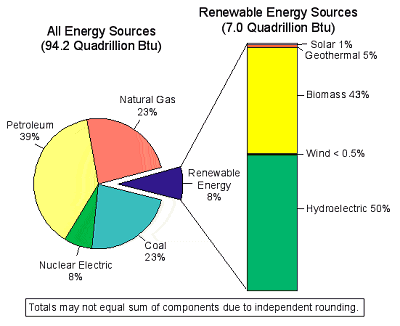|
Renewable
energy refers to sources of energy that are always there.
While this energy must be finite, due to entropy and the laws
of thermodynamics, the supply is so large that there is no
foreseeable end in our or our children's lifetimes. Solar
energy is one of the most common examples. The sun comes up
every day and hopefully will continue to do so for another
5 billion years or so.
You might
think that we would be tapping these energy resources, but
there is a catch. While the energy is there, the cost of getting
it is actually greater than using our more popular energy
sources of fossil fuels and uranium. As we run out of our
supply of fossil fuels and uranium or the cost of these fuels
rises for economic or political reasons, the cost of renewable
energy may become much more competitive.
The other
important advantage of renewable energy is that it produces
much less pollution. Some people believe that if the true
costs of pollution, like the medical costs of cancer, were
factored into the cost of fossil fuels and uranium, that renewable
energy is already cost effective and should be used much more
often.
Another
requirement to make renewable energy more competitive is more
research. The United States government has cut funding for
research into solar and other renewable energy. This has left
the United States even more likely to be dependent on oil
imports far into the future.
Following
is a graph that shows the % of our total energy provided by
renewable energy.

Courtesy
of
Renewable Energy Annual
web site
A number
of renewable types of energy are listed below along with a
brief description.
Solar
Energy
Solar
energy is provided by the light energy that comes from the
sun. There are a number of ways to harness this energy. There
is direct solar heating
in which the light energy is allowed to heat a house through
transparent windows or heat a mass of water which can then
be circulated to heat the home. There is photovoltaics
where the light energy is transferred into electrical
energy by the use of solar panels. For example, these panels
can be attached to the roof of a house. Also many satellites
use solar panels for their power needs. Finally there is thermal
electric energy where the sun light is reflected and focused
using a huge parabolic mirror. This reflected light energy
can then be used to heat water to create steam which can be
used to drive a turbine to produce electricity just like in
a conventional power plant. Some areas of the country are
more conducive to the use of solar energy than others. Areas
like the southwest where the sun is shining most of the time
and the temperatures are seldom very low are the best candidates.
Over
the years the efficiencies of solar cells, which are not very
high, have been increasing. If these efficiencies could be
increased further, then solar energy could become competitive
as an energy resource.
One way
that you can utilize solar energy is to buy a solar calculator.
You will never have to buy batteries again, which not only
saves energy but also the pollution involved with disposing
of the batteries.
Wind
Energy
Wind
energy is the kinetic energy contained in the movement of
a mass of air molecules. The wind can be used to turn a turbine,
which can then produce electricity using a generator. Many
wind turbines are relatively small, and large numbers are
required to produce appreciable amounts of energy. Again,
certain areas of the country are particular suitable for wind
turbines. The coast of California, for example, has cliffs
that receive high winds on a consistent basis.
A
number of wind turbines, together referred to as wind farms,
have been constructed in the state of Pennsylvania. Residents
there can choose to purchase some or all of their electricity
from these wind farms, thereby saving pollution that would
be created if the electricity was generated from fossil fuels.
Similar
programs may be available in your local area.
Biomass
Energy
Biomass
energy is generated by the decay of large masses of plant
or animal material or waste which forms methane and other
combustible gases. These gases contain chemical energy, which
when burned can be used to generate electricity. Gas can even
be extracted from large landfills, where the waste deposits
that are part of the landfill generate the gas over time.
Geothermal
Energy
Geothermal
energy is heat energy that comes from the molten interior
of the earth. There are places where this molten material
is close enough to the surface where it can be harnessed.
The heat energy is used to produce steam and as usual turns
a turbine to generate electricity.
|

